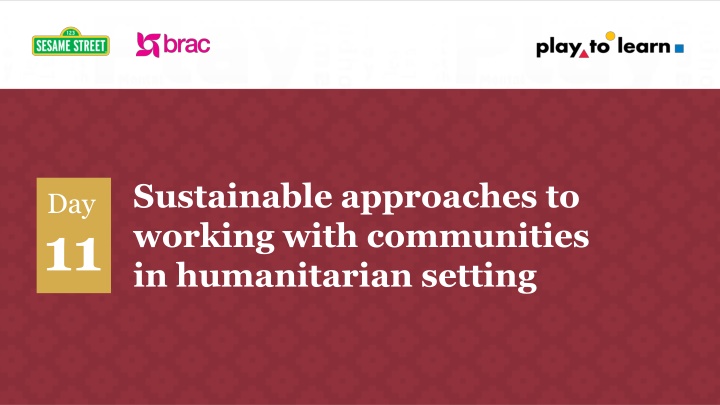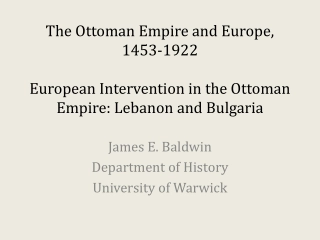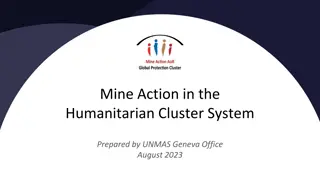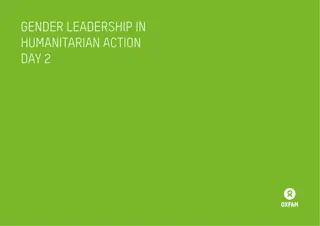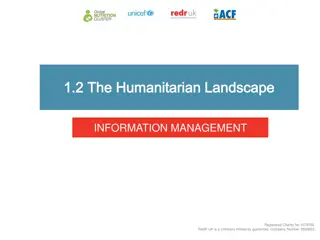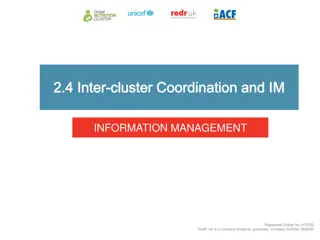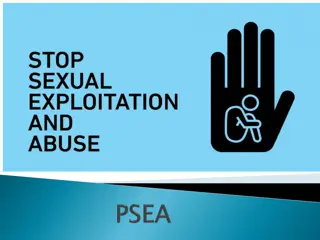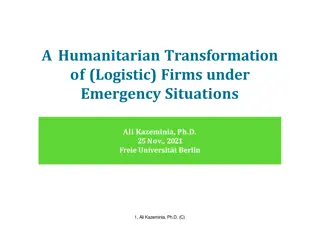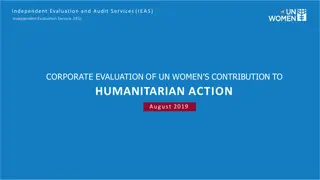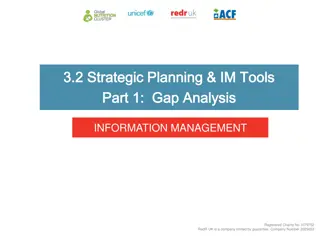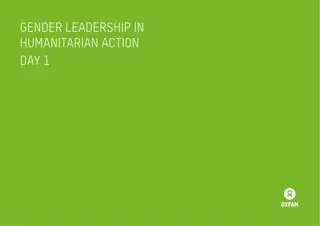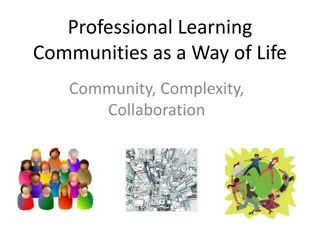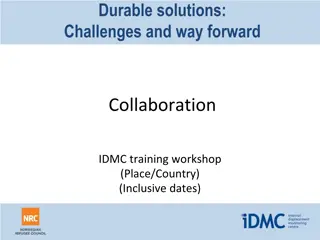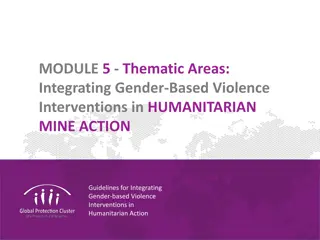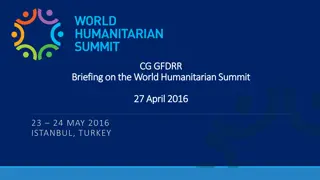Sustainable Approaches to Working with Communities in Humanitarian Settings
Sustainability in humanitarian action involves integrating environmental, social, and economic considerations throughout the response cycle, aiming to meet immediate needs while considering long-term impacts. Sustainable programming in the face of forced displacement is crucial for empowerment and long-term solutions.
Download Presentation

Please find below an Image/Link to download the presentation.
The content on the website is provided AS IS for your information and personal use only. It may not be sold, licensed, or shared on other websites without obtaining consent from the author.If you encounter any issues during the download, it is possible that the publisher has removed the file from their server.
You are allowed to download the files provided on this website for personal or commercial use, subject to the condition that they are used lawfully. All files are the property of their respective owners.
The content on the website is provided AS IS for your information and personal use only. It may not be sold, licensed, or shared on other websites without obtaining consent from the author.
E N D
Presentation Transcript
Sustainable approaches to working with communities in humanitarian setting Day 11
Learning Outcome 1 Participants will be able to explain the concept of sustainability in humanitarian context 2 Participants will articulate the various dimensions of sustainability to consider when designing interventions. 3 Participants will Identify and evaluate challenges related to sustainability and identify strategies to promote it in their intervention designs.
Sustainability in the humanitarian crisis context refers to the ability of humanitarian action to meet the immediate needs of affected populations while also considering the long-term consequences of those actions on the environment, society, and economy (DARA, 2011). This approach aims to ensure that humanitarian interventions do not inadvertently exacerbate existing vulnerabilities or create new ones, and that they contribute to building resilience and sustainable development in crisis-affected communities (UNEP, n.d.). According to DARA (2011), sustainability in humanitarian action involves integrating environmental, social, and economic considerations into all phases of the humanitarian response cycle, from preparedness and planning to implementation, monitoring, and evaluation. This may include measures such as reducing the environmental footprint of humanitarian operations, promoting local participation and ownership, and supporting the development of sustainable livelihoods and infrastructure (FutureLearn, n.d.). What is sustainability in Humanitarian context? Example In practice, sustainability in humanitarian action can take many forms, depending on the specific context and needs of the affected population. For example, in a natural disaster, sustainability might involve ensuring that relief efforts do not contribute to deforestation or pollution, and that they support the restoration of ecosystems and natural resources (UNEP, n.d.). In a conflict setting, sustainability might involve promoting social cohesion and reconciliation, protecting human rights, and supporting the development of peacebuilding initiatives (DARA, 2011).
In recent years, there has been a significant increase in forced displacement worldwide. The total number of displaced individuals has surged from under 42 million in 2013 to a staggering 120 million by mid-2024. Many of these people have endured displacement for more than five years. Factors such as persecution, conflict, violence, and human rights violations contribute to this crisis, which is further exacerbated by state fragility, poverty, and the impacts of climate change. Importance of Sustainable Programming in Humanitarian Context Amidst this challenging landscape, receiving states, host communities, donor nations, and international humanitarian aid organizations find themselves stretched thin. Sustainable programming becomes crucial in this context. It aims to enhance self-reliance among forcibly displaced populations while minimizing their dependence on short-term humanitarian assistance. By establishing sustainable services such as education, healthcare, housing, and water access we can allocate resources more effectively, ultimately working toward long-term solutions and protection. At its core, sustainable programming prioritizes community empowerment and human development. This approach involves collaboration with host governments, development partners, civil society, the private sector, and most importantly, the forcibly displaced individuals themselves.
Question Which of the following statements best captures the essence of sustainability in humanitarian action, as discussed in the context of the presentation? A) The capacity of humanitarian interventions to solely address the immediate needs of affected populations. B) The ability of humanitarian actions to meet immediate needs while also considering long-term environmental, social, and economic impacts. C) The exclusive focus on long-term development goals without addressing immediate humanitarian needs. D) The prioritization of economic growth over social and environmental considerations in humanitarian response. Answer
Question Which of the following statements best captures the essence of sustainability in humanitarian action, as discussed in the context of the presentation? A) The capacity of humanitarian interventions to solely address the immediate needs of affected populations. B) The ability of humanitarian actions to meet immediate needs while also considering long-term environmental, social, and economic impacts. C) The exclusive focus on long-term development goals without addressing immediate humanitarian needs. D) The prioritization of economic growth over social and environmental considerations in humanitarian response. Answer B) The ability of humanitarian actions to meet immediate needs while also considering long-term environmental, social, and economic impacts.
Dimensions of Sustainability in Humanitarian Context 01 02 03 04 05 Behavioral Service Institutional Financial Environmental
Behavioural Sustainability Behavioural Sustainability is behavior that encompasses peoples' values, norms, beliefs, senses of responsibility in deliberate actions focused to providing well-being of all living beings, including present and future generations. Behavioral sustainability delves into the values, norms, beliefs, and actions of individuals and communities that contribute to the well-being of all living beings, both present and future. It recognizes that sustainable practices are deeply intertwined with cultural contexts and social norms. For instance, research by the International Institute for Environment and Development has highlighted the significance of local knowledge and community participation in disaster risk reduction. In Bangladesh, community-led initiatives have played a pivotal role in improving cyclone preparedness and response, demonstrating the power of behavioral change in building resilience (Paul, 2018).
How would you incorporate behavioral sustainability into a disaster relief project in a remote community?
Sustainability of services Sustainability of services in the humanitarian context refers to the ability to maintain and deliver essential services to crisis-affected populations over the long term, even after the initial emergency response has subsided. This involves not only the physical infrastructure (such as hospitals, schools, and water systems) but also the processes, systems, and resources needed to ensure the continued functioning of these services. For Example In the aftermath of the 2010 Haiti earthquake, international organizations and local partners worked together to rebuild damaged hospitals and clinics. However, ensuring the sustainability of these healthcare services required not only the physical reconstruction of infrastructure but also the training of local healthcare workers, the establishment of supply chains for medicines and equipment, and the development of sustainable financing mechanisms (OCHA, 2011).
Sustainability of services The concept of sustainability of services is rooted in several theoretical frameworks: Systems Thinking Capacity Building Community Participation This approach emphasizes the interconnectedness of various components within a service delivery system. It recognizes that the sustainability of services depends on the effective functioning of all elements, including infrastructure, human resources, financial resources, and governance mechanisms (Meadows, 2008). This framework highlights the importance of strengthening the skills, knowledge, and resources of local actors to manage and maintain services independently. It emphasizes the need for training, mentorship, and institutional development to ensure the long-term viability of services (Chaskin, 2001). This approach emphasizes the active involvement of affected communities in the design, implementation, and monitoring of services. It recognizes that community ownership and participation are crucial for ensuring that services are relevant, responsive, and sustainable (Twigg, 2004).
Institutional sustainability Institutional sustainability in the humanitarian context refers to the ability of organizations and systems involved in humanitarian response to maintain their functions, operations, and effectiveness over the long term. This ensures the continuity of humanitarian assistance and support to affected populations even after the initial crisis phase has passed. It involves building strong and resilient institutions, systems, and processes that can adapt to changing circumstances and continue to deliver essential services and support to those in need. Several key elements contribute to institutional sustainability in the humanitarian context: Strong Leadership and Governance Financial Stability Human Resources Community Engagement Adaptability and Innovation Organizational Capacity
Financial sustainability Financial sustainability in the humanitarian context, refers to the ability of humanitarian organizations and projects to secure and manage resources effectively to ensure the continuity and effectiveness of their operations over the long term. This involves not only securing adequate funding but also establishing sound financial management practices, diversifying funding sources, and building the capacity of local actors to eventually take ownership of and sustain humanitarian initiatives. Key Aspects of Financial Sustainability in the Humanitarian Context: Reliable and Diverse Funding Sources Diversification helps to mitigate risks associated with over-reliance on a single funding source and ensures greater financial stability. Effective Financial Management Tracking expenses, monitoring program performance, and evaluating the impact of humanitarian interventions. Local Capacity Building Providing training, technical assistance, and financial support to enable local actors to manage and sustain humanitarian programs over time Cost-Effectiveness and Efficiency Identifying and implementing innovative approaches, leveraging technology, and collaborating with other actors to avoid duplication of efforts. Long-Term Planning Investing in sustainable livelihoods, infrastructure development, and disaster risk reduction measures to reduce the need for future humanitarian assistance.
Key stakeholders such as NGOs, the private sector, national bodies, and local communities, all play crucial roles in fostering financial sustainability in the humanitarian context. They contribute to financial sustainability by providing financial and technical support to humanitarian organizations, advocates for increased funding for humanitarian crises, and develops policies and guidelines to promote sustainable practices. Collaborative Approaches to Financial Sustainability: The Role of Various Stakeholders Financial sustainability is closely linked to the broader concept of sustainable development, which emphasizes the interconnectedness of economic, social, and environmental dimensions. In the humanitarian context, financial sustainability is not only about ensuring the continuity of services but also about contributing to the long-term well-being and resilience of crisis-affected communities.
Financial sustainability Environmental sustainability in the humanitarian context refers to the ability of humanitarian actions to meet the immediate needs of affected populations while minimizing negative long-term consequences on the environment (DARA, 2011). This involves integrating environmental considerations into all phases of humanitarian response, from preparedness and planning to implementation, monitoring, and evaluation. Some approaches to environmental sustainability in humanitarian settings include: Reducing the environmental footprint of humanitarian operations Minimizing waste, using renewable energy sources, and adopting eco-friendly practices in the construction and operation of camps and other facilities. Promoting local participation and ownership Engaging local communities in environmental decision-making and empowering them to manage natural resources sustainably can help to ensure the long-term viability of humanitarian interventions. Supporting the restoration of ecosystems and natural resources In the aftermath of disasters or conflicts, it is important to prioritize the restoration of damaged ecosystems and natural resources to support the livelihoods and well-being of affected populations. Integrating environmental considerations into all phases of the humanitarian response cycle This means considering the environmental impact of all humanitarian activities, from the procurement of goods and services to the disposal of waste.
Challenges in pursuing sustainability The pursuit of sustainability in humanitarian settings faces a myriad of challenges. Addressing them requires a multi-faceted approach that involves collaboration, capacity building, innovative financing mechanisms, and a commitment to environmental and social responsibility. Capacity Building: Building the capacity can be hindered by limited resources, lack of skilled personnel, and weak institutional frameworks (Hilhorst & Jansen, 2010). Funding Constraints: Humanitarian organizations often face funding shortages, which can limit their ability to implement sustainable solutions. This is particularly challenging in protracted crises, where donor fatigue can set in (Stoddard et al., 2017). Political and Security Challenges: In conflict-affected areas, political instability and security concerns , humanitarian actors may face restrictions on access, threats to their safety, and difficulties in engaging with local communities (Stoddard et al., 2017). Environmental Concerns: Balancing the immediate needs of affected populations with environmental sustainability can be a complex challenge (UN Environment Programme, 2021). Community Participation: Ensuring genuine participation can be difficult due to power imbalances, cultural barriers, and lack of trust (Hilhorst & Jansen, 2010). Monitoring and Evaluation: Monitoring and evaluation systems can be resource-intensive and may not always capture the long-term effects of programs (Hilhorst & Jansen, 2010).
Known practices to promote sustainability Co-creating programmes with communities Capacity building of community members Generating evidences for advocacy to sustain project services through government or UN systems Integrated services and coordination
Co-creating Co-creating programmes with communities is a collaborative approach that actively involves community members in the design, implementation, and evaluation of humanitarian initiatives. By engaging local leaders, residents, and organizations in the planning and decision-making processes, these programmes are tailored to the specific needs and cultural contexts of the community. This approach leverages local knowledge and expertise, leading to more effective and relevant solutions. Additionally, it fosters a sense of ownership and responsibility among community members, encouraging their active participation and empowering them to take control of their own development and recovery processes. Building trust and strengthening relationships between humanitarian actors and the community also enhance collaboration and long-term commitment, making the programmes more sustainable. programmes with communities
Co-creating QUESTION: Explain the concept of "co-creation" in the context of humanitarian programs. According to you, what are its potential benefits for both the community and humanitarian organizations? programmes with communities ANSWER:
Co-creating ANSWER: programmes with communities Co-creation in humanitarian settings refers to the active involvement and collaboration of community members throughout the entire program cycle - from design and planning to implementation and evaluation. It recognizes the community as equal partners, leveraging their local knowledge, expertise, and priorities to develop solutions that are contextually relevant and sustainable. Potential Benefits: For the Community: Increased ownership and sense of empowerment, culturally sensitive and relevant programs, enhanced sustainability and long-term impact. For Humanitarian Organizations: Improved program effectiveness and relevance, stronger community relationships and trust, increased efficiency through local knowledge and resources.
Case for Co-creating An unpublished study by NYU Global TIES on BRAC s Humanitarian Play Lab (HPL) model has revealed a significant interest among the Rohingya community members in establishing HPL centres upon their return to their home country. The appeal of the HPL model lies in its culturally sensitive curriculum that promotes learning through play. This sentiment among the Rohingya community underscores the potential for effective project initiatives to have a lasting impact, extending beyond the lifespan of the original project. programmes with communities
Capacity building of community Capacity building focuses on enhancing the skills, knowledge, and abilities of community members, enabling them to manage future crises independently and take charge of their development. This involves providing training sessions, workshops, and educational opportunities to improve technical skills and knowledge. Leadership development is also crucial, as it identifies and nurtures local leaders who can drive community initiatives and represent the community in broader forums. By teaching effective resource management practices, communities can ensure the sustainable use of their local resources. This approach fosters a culture of self-reliance, reducing dependency on external aid and empowering communities to solve problems and make decisions independently. members
QUESTION: Which of the following is a key component of capacity building in community members within humanitarian settings? Capacity building of community members A) Providing financial aid directly to individuals B) Leadership development and mentorship C) Imposing external solutions on the community D) Focusing solely on short-term relief efforts ANSWER:
QUESTION: Which of the following is a key component of capacity building in community members within humanitarian settings? Capacity building of community members A) Providing financial aid directly to individuals B) Leadership development and mentorship C) Imposing external solutions on the community D) Focusing solely on short-term relief efforts ANSWER: B
Case for Capacity building of community members Under the Play to Learn project, BRAC made substantial investments in training facilitators on the Humanitarian Play Lab (HPL) model. This training enabled them to operate both centre-based and home-based interventions. As the project neared its end and the HPL centres began to close, these facilitators leveraged the skills and knowledge they had acquired through BRAC s capacity development initiatives. They established home-based childcare facilities within their own homes, providing crucial support to working parents in the camps by caring for their children during their absence. These home-based facilities not only provide a source of income for the facilitators but also continue to offer early learning and development opportunities for children.
Integrated services and coordination Integrated services and coordination involve the seamless collaboration of various sectors and stakeholders to deliver comprehensive and cohesive support to affected communities. This multisectoral approach combines efforts across different sectors such as health, education, water and sanitation, and livelihood support, ensuring that all aspects of the community s needs are addressed holistically. Effective stakeholder collaboration fosters partnerships among governments, NGOs, international organizations, and the private sector, enhancing the effectiveness and reach of humanitarian actions. Establishing systems for efficient information sharing and communication among stakeholders prevents duplication of efforts and ensures optimal resource allocation. By ensuring a continuum of care and support, from immediate relief to long- term recovery and development, this approach enhances the overall resilience of the community.
QUESTION: Why is an integrated, multi-sectoral approach crucial for achieving sustainability in humanitarian programs? Integrated services and coordination ANSWER:
ANSWER: Integrated services and coordination An integrated approach recognizes the interconnectedness of various sectors (health, education, livelihoods, etc.) and the need to address them comprehensively to foster long-term community resilience. It avoids fragmented efforts and ensures that all aspects of the community's needs are considered.
Cases for Integrated services and coordination The BRCiS (Building Resilient Communities in Somalia) Program: Context Somalia has faced chronic food insecurity and conflict for decades. The BRCiS program, implemented by a consortium of NGOs, aimed to address these challenges in a holistic manner. Integration The program combined food security interventions with livelihood support, water, sanitation, and hygiene (WASH) services, and peacebuilding initiatives. Sustainability Outcomes By providing a multifaceted approach, the BRCiS program not only delivered immediate relief but also fostered long-term resilience in communities. Farmers received training and resources to improve agricultural practices, leading to increased food production and less dependence on external assistance. WASH services, along with hygiene promotion, improved health outcomes and reduced waterborne illnesses. Peacebuilding initiatives fostered collaboration and conflict resolution skills, contributing to a more stable environment for long-term development.
Evidence-Based Advocacy for Sustainable Humanitarian Programming: Engaging All Stakeholders Generating evidence for advocacy involves systematically collecting and analyzing data to showcase the impact and effectiveness of humanitarian programs. Rigorous monitoring and evaluation processes provide valuable quantitative and qualitative data on program outcomes. This evidence serves as a powerful tool to advocate for continued support, policy changes, and increased funding from a wide range of stakeholders, including governments, UN agencies, NGOs, the private sector, and crucially, the affected communities themselves. Evidence-based advocacy plays a pivotal role in ensuring the sustainability and long-term impact of humanitarian interventions. By demonstrating the positive outcomes and successful strategies, it encourages collaboration and partnerships among various stakeholders to integrate and scale up effective programs within existing systems.
Key strategies for evidence- based advocacy Developing comprehensive monitoring and evaluation frameworks to capture the multifaceted impact of humanitarian programs. Utilizing data visualization and storytelling techniques to effectively communicate program results to diverse audiences. Engaging in proactive dialogue and collaboration with policymakers, donors, and community leaders to influence policy development and resource allocation. Developing sustainability plans that outline strategies for long-term program maintenance and transition to local ownership. Fostering a culture of learning and adaptation within humanitarian organizations to continuously improve program effectiveness and sustainability.
BRCIS: Building Resilient Communities in Somalia Phase 2 - Somalia. (2023, February 25). ReliefWeb. https://reliefweb.int/report/somalia/brcis-building-resilient- communities-somalia-phase-2 DARA. (2011). Sustainability in humanitarian action. https://daraint.org/wp-content/uploads/2011/12/Sustainability-in- humanitarian-action.pdf References FutureLearn. (n.d.). Sustainability in Humanitarian Action. https://www.futurelearn.com/courses/sustainable-development- humanitarian-action UNEP. (n.d.). Environmental sustainability of humanitarian action. https://www.unep.org/topics/disasters-and-conflicts/response-and- recovery/environmental-sustainability-humanitarian Paul, B. G. (2018). Community-based disaster risk reduction: A case study of Bangladesh. Journal of Disaster Risk Studies, 11(1), 1-10.
